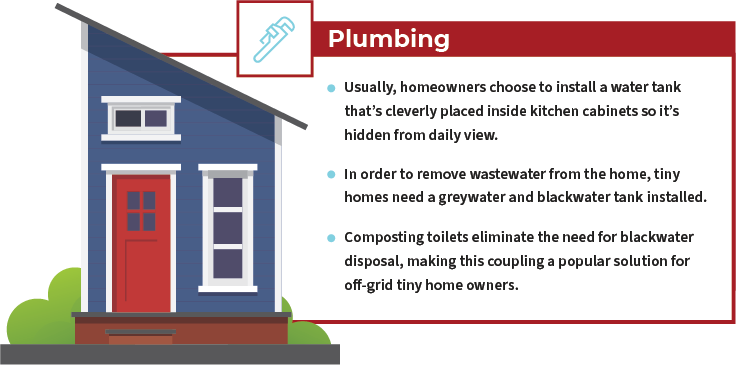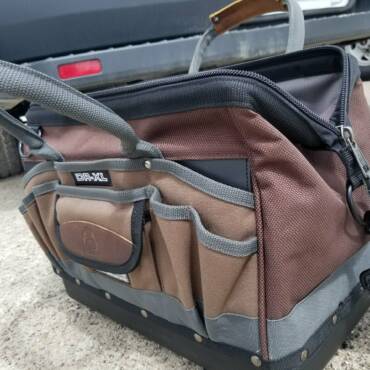back to blog
Tiny home living is sweeping the nation — and for good reason. Cost-effective, eco-conscious, and sustainable, tiny house living is a great option for those looking to reduce their carbon footprint and save on expensive mortgages and property costs.
While tiny homes offer much in the way of economic and environmental savings, there is a learning curve associated with taking on the minimalist lifestyle. For example, homeowners will need to find alternative methods for handling their heating, cooling, and plumbing needs. HVAC and plumbing systems in traditional homes are far too large for a tiny home construction. Not only that, but many tiny homes are mobile, meaning a centralized HVAC or plumbing system would not be the ideal solution.
Finding the right HVAC and plumbing solution for your tiny home takes a great amount of research and consideration. From size and cost to portability and maintenance, we break down everything you need to know about heating, cooling, and plumbing while living the tiny life.
What Is Considered a Tiny Home?
Tiny houses are a part of the small house movement, which is defined as a return to residences with less than 1,000 square feet of space. However, in order for a home to be considered “tiny,” it must have no more than 400 square feet. In fact, some homes can be as small as 80 square feet.
Because tiny homes are more difficult to regulate in terms of zoning and safety, many states have made these dwellings more difficult to obtain. While they aren’t exactly “illegal,” certain states — such as Connecticut — have made it increasingly difficult for tiny homes to be approved by their city zoning and safety boards. According to Tiny House Society, Texas and Maine are the friendliest states when it comes to allowing tiny house dwellings.
Some of the key safety considerations when creating a tiny home are its heating, cooling, and plumbing systems. Outfitting the home with a system that’s too large can have serious consequences, including septic issues, water contamination, and house fire.
Finding the right plumbing and HVAC system for a tiny home can be a challenge for other reasons as well: Tiny homes can either be on the grid or off the grid, and may be mobile or stationary. It’s important to find a system that’s performance-ready for the specific tiny home construction you have.
Understanding Tiny Home Plumbing


Plumbing Solutions for Tiny Homes
Whether your tiny home is on or off the grid, the first step to a successful plumbing system is getting water access where you need it most. Usually, homeowners choose to install a water tank that’s cleverly placed inside kitchen cabinets so it’s hidden from daily view. This is where water is stored for later use. If you’re on-grid, you’ll fill the tank by connecting an RV hose to the water supply. Owners of off-grid tiny homes will need to carry water jugs to fill the unit.
Once you’ve filled the water tank, the next step is to heat and pressurize it to fit your needs. For off-grid homes, this is typically achieved by using a tankless propane water heater and water pressure pump. Most homeowners use a gas or solar-powered generator to act as the pump’s power supply. Those living on the grid won’t need a water pressure pump, but they may benefit from using a heated water hose during the colder months to prevent against freezing.
Fresh water isn’t the only consideration tiny home owners need to make for their fun-sized dwellings: They also need a way to remove wastewater from their home. In general, tiny homes will need a greywater and blackwater tank installed as well. Greywater tanks collect runoff from sinks and bathtubs while blackwater is specifically for toilet wastewater.
Plumbing Challenges for Tiny Home Owners
Typically, the more off-grid the home, the more involved your plumbing process will be. For example, on-the-grid tiny homes have the luxury of hooking up to a public sewer or septic system with an RV hose to remove greywater and blackwater waste from their homes. Those who live off the grid, however, do not have this same advantage: Instead, they must take their blackwater and greywater tanks to the appropriate dumping stations, which may require them to travel a great length depending on how far removed they are from the nearest station.
Two ways off-grid homeowners address this issue are through recycled plumbing and composting toilets. Recycled plumbing is when homeowners send greywater through pipes from their home to the ground in a section of the yard that irrigates a garden. Composting toilets eliminate the need for blackwater disposal, making this coupling a popular solution for many tiny home owners.
Understanding Tiny Home HVAC



Types of Tiny Home HVAC Systems
When it comes to tiny homes, the name of the game is maximizing space. That can be a challenge when it comes time to select a heating and cooling system for the home. Traditional units typically have a series of ducts that can eat up a lot of valuable space in a tiny home, making them an unrealistic solution for many tiny home owners. Some homeowners choose the smaller ducted systems used in mobile homes to compensate for their heating and cooling needs; however, this may not be possible if the space is particularly small.
Luckily, the options don’t end at ducted units: Ductless mini-split systems are a great option for tiny homes. These small systems are mounted to the wall or ceiling and connected to an exterior heat pump. You can install more than one unit in a dwelling depending on its size and the specific zones in the home in which you need heating or cooling.
Still another solution is portable heaters and air conditioners. These units are rated for the specific square footage of your home while taking up the least amount of space. It’s important to note, however, that most portable heaters require at least three feet of space to operate safely. If this isn’t possible in your tiny home, it may not be the best solution.
Additional HVAC solutions include:
- Wood Stoves: These systems provide ample heating in the winter and can be used to either heat the home or cook. They typically require a range hood and air exchanger to operate.
- Packaged Terminal Air Conditioner: Also known as a PTAC, these systems are commonly used in hotels and are contained within one unit. Some also have a resistive electric heating element rather than a heat pump, allowing for heating in the winter.
- Vertical Terminal Air Conditioner: Called a VTAC, these systems are usually installed in closets or other out-of-sight places. They feature quiet operation and provide heating and cooling capabilities to the home.
HVAC Challenges in Tiny Homes
HVAC challenges in tiny homes largely depend on the type of system in place. For example, portable units — such as window A/C units — will need to be stored between seasons. With such limited space in the home, this might create a hinderance as homeowners struggle for room. Safety concerns are also a top priority for portable units: HVAC systems of any kind need ample space to ensure safe operation. As aforementioned, a space heater will usually need about three feet of operating space to prevent against a fire event.
In addition to safety and storage, tiny home owners must optimize their dwellings for energy efficiency to prevent against overspending on their energy bills. Air transmission, insulation, skirting, and windows are all key considerations for homeowners to make to enhance their home’s HVAC efficiency. Be sure to optimize air transmission throughout your tiny home by installing separate units in loft areas if necessary. Homeowners can also increase efficiency by installing better insulation, thicker windows, and skirts around the bottom of the home to prevent against thermal transfer in the floors.
Tiny Home HVAC & Plumbing FAQs
What kind of toilets are most commonly installed in tiny homes?
Most tiny home owners opt for composting toilets or RV toilets with waste tanks to accommodate their wastewater needs. Some homeowners even install sawdust toilets for a more sustainable, eco-friendlier solution. It all boils down to personal preference, as well as whether or not your home is on-grid or off-grid.
How do owners of tiny homes deal with wastewater?
Wastewater is broken down into two categories: greywater and blackwater. Greywater is the runoff that comes from your kitchen sink and bathtub while blackwater refers to the waste from your toilet. Both wastewater types must follow the appropriate dumping guidelines to prevent against environmental contamination. On-grid homeowners can connect to a public sewer or septic line through an RV hose to dispose of their wastewater. However, off-grid tiny home owners will need to transport their wastewater to a dump site.
What is the smallest central heat and air conditioning unit?
There are a broad range of central heating and air conditioning units available for tiny spaces. In order to find the smallest system that provides the best performance, homeowners will need to calculate their square footage and select a model with the appropriate BTU capacity. For instance, a home that’s 350 square feet will need a unit with a capacity of at least 9,000 BTUs.
Sherlock Plumbing, Heating & Air for Your Tiny Home’s Needs
If you’ve taken on the tiny life and are seeking portable plumbing, heating, and cooling solutions for your tiny home, don’t hesitate to reach out to the professional team at Sherlock Plumbing, Heating & Air. Our expert plumbing and HVAC technicians have the skills and tools available to bring high-quality heating, cooling, and plumbing to your home — no matter how big or small it may be.
Find the solutions you need by contacting our team today!
Whether you require installation, repair, or maintenance, our technicians will assist you with top-quality service at any time of the day or night. Take comfort in knowing your indoor air quality is the best it can be with MOE heating & cooling services Ontario's solution for heating, air conditioning, and ventilation that’s cooler than the rest.
Contact us to schedule a visit. Our qualified team of technicians, are always ready to help you and guide you for heating and cooling issues. Weather you want to replace an old furnace or install a brand new air conditioner, we are here to help you. Our main office is at Kitchener but we can service most of Ontario's cities
Source link




Add Comment